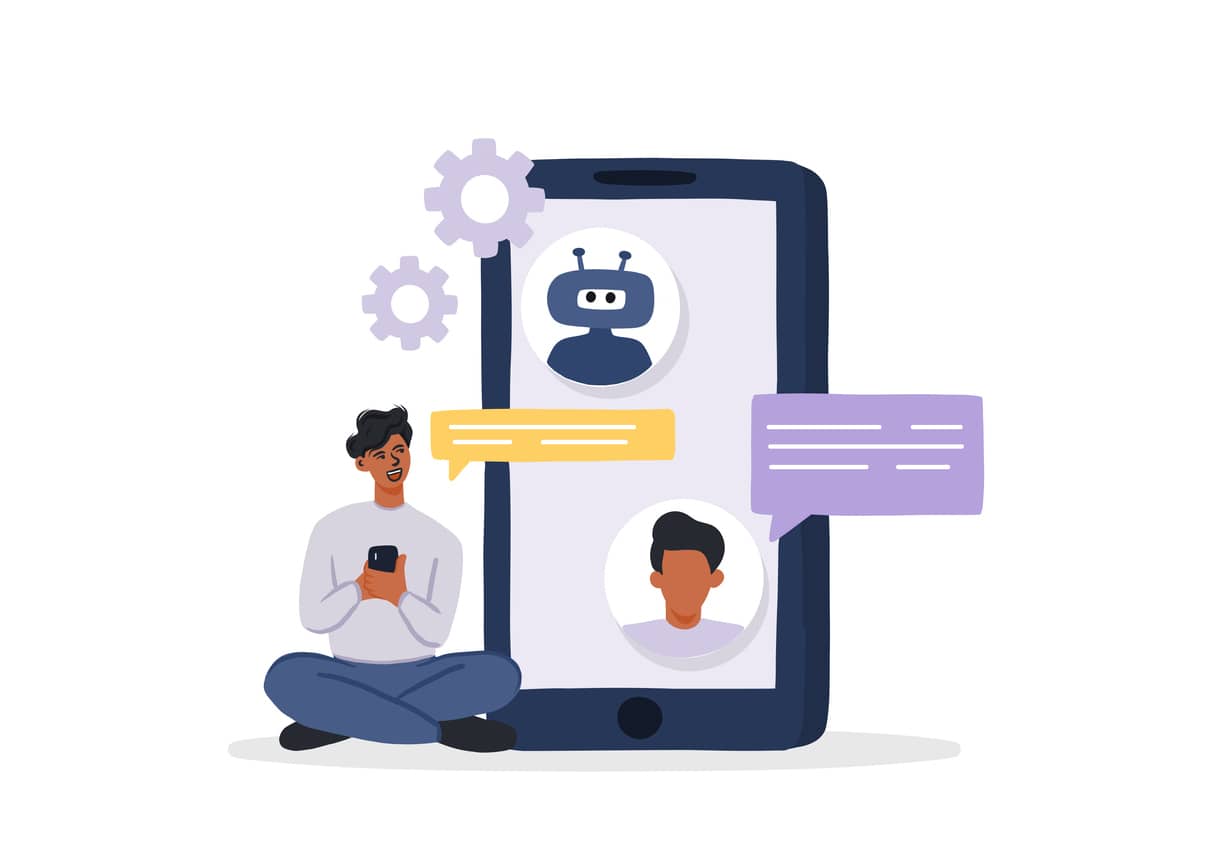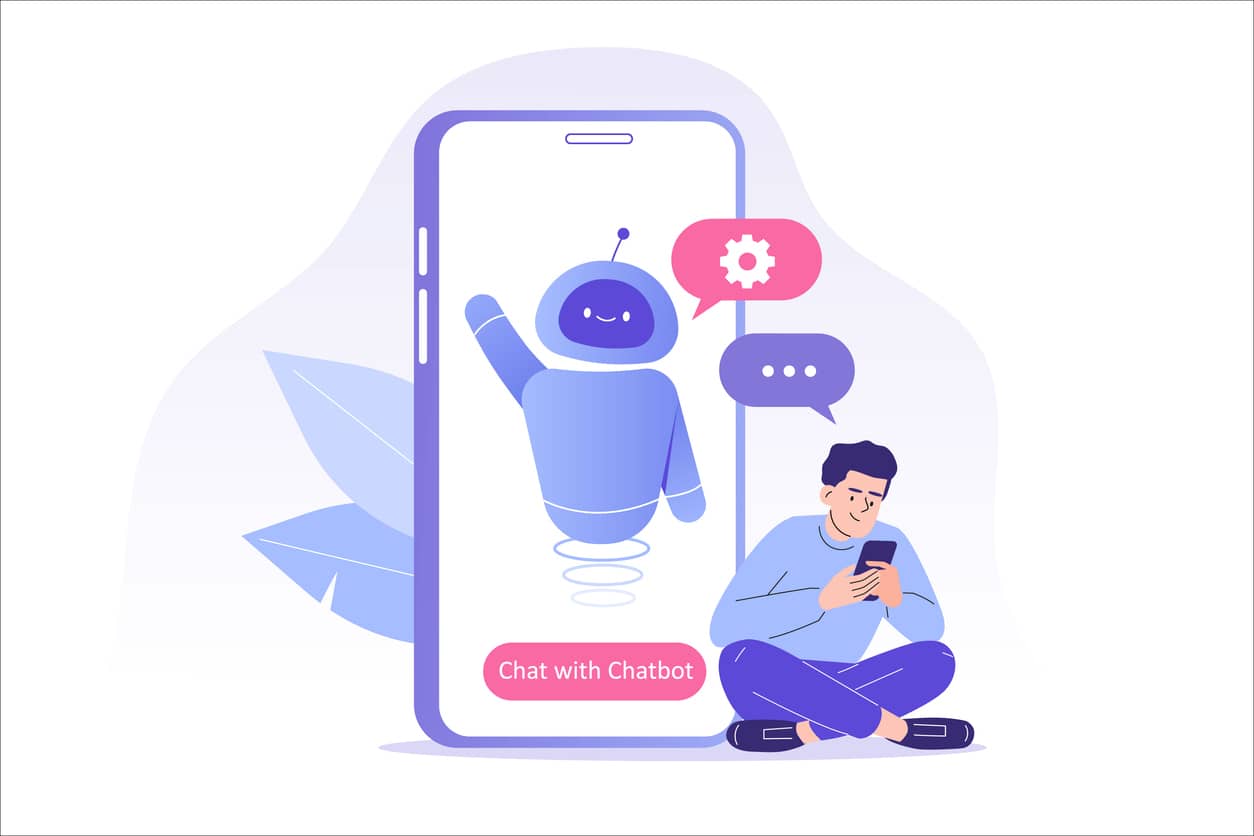While the concept of chatbots may seem cutting-edge, they have been around for decades. The first one, ELIZA, was created in the 1960s. Over the years, advancements in artificial intelligence and natural language processing have propelled chatbots into a new era of sophistication and usability.
Now that we understand what chatbots are, let’s delve into their diverse applications and demystify their role in enhancing daily operations.
Application areas for chatbots
Chatbots are pivotal in modern business, but their possible uses are extensive. It can be hard to know how exactly chatbots can fit into our roles.
So here are some specific uses of chatbots in the workplace.
Customer support and automated assistance
Chatbots are widely recognized for their ability to revolutionize customer service. They act as virtual assistants, promptly responding to customer queries and providing real-time support. What sets them apart is their ability to handle many questions simultaneously, ensuring efficient and personalized assistance.
For instance, in e-commerce, chatbots serve as virtual shopping assistants, guiding customers through product selection, offering personalized recommendations, and even facilitating seamless checkout processes.
In the banking sector, chatbots streamline routine inquiries, such as checking account balances or transaction history, allowing human agents to focus on more complex financial matters.
These examples underscore the versatility of chatbots, demonstrating their ability to enhance customer experiences across various industries by providing efficient and personalized support.
Automating repetitive tasks
Businesses often find themselves mired in repetitive tasks that consume valuable time. Enter chatbots – automated agents capable of streamlining processes by handling routine inquiries, data entry, and other mundane tasks. This not only frees up human resources but also minimizes errors.
For instance, in project management, chatbots can automate task progress tracking, send reminders for deadlines, and update team members on project milestones.
Chatbots can streamline the onboarding process in HR by handling routine paperwork and providing new employees with essential information. Beyond paperwork, chatbots serve as informational hubs during the onboarding journey. They can give new employees essential information about company policies, procedures, and organizational culture. From details about office protocols to insights into team dynamics, chatbots ensure newcomers receive comprehensive and timely information, fostering a smoother transition into the organizational ecosystem.
Moreover, chatbots’ interactive nature enables them to answer queries in real-time, offering a personalized touch to the onboarding experience. New employees can seek clarification on company policies, inquire about the structure of their benefits packages, or receive guidance on the logistics of their first days. This proactive engagement not only enhances the efficiency of the onboarding process but also contributes to the overall satisfaction and engagement of new team members.
These examples illustrate how chatbots seamlessly integrate into various business functions, relieving professionals of repetitive tasks, saving time, and reducing the likelihood of errors.

Customer engagement and loyalty
Enhancing customer engagement is a key focus for any organization. Chatbots contribute by initiating meaningful conversations, providing product recommendations, and conducting surveys. Businesses can foster customer loyalty and satisfaction by offering a seamless and interactive experience.
Consider the retail sector, where chatbots engage customers by offering personalized product recommendations based on their preferences and purchase history. For instance, imagine a scenario where a customer, having previously browsed specific product categories or brands, initiates a conversation with a retail chatbot. Drawing from the customer’s historical data, the chatbot can intelligently suggest complementary items, present new arrivals matching their style, or even offer exclusive promotions based on their purchase patterns.
In the hospitality industry, chatbots facilitate reservations, gather feedback through post-stay surveys, and provide relevant information about amenities, contributing to an enhanced guest experience. One of the primary functionalities of chatbots in the hospitality sector is facilitating reservations. Guests can interact with these intelligent agents to inquire about room availability, explore different accommodation options, and swiftly complete the reservation process. By providing real-time information on room rates, promotions, and available amenities, chatbots simplify the booking experience, offering a convenient and efficient way for guests to secure their accommodations.
These examples demonstrate how chatbots actively initiate meaningful interactions, tailor recommendations, and collect valuable feedback, all playing pivotal roles in fostering customer loyalty and satisfaction across diverse industries.
Access to information
In a world inundated with data, swiftly accessing relevant information is crucial. Chatbots act as information hubs, swiftly retrieving data from Microsoft 365 and other sources. Whether it’s updating project statuses or retrieving documents, chatbots simplify the process, saving both time and effort.
For example, in project management, a chatbot can provide real-time updates on project statuses, ensuring team members are well-informed without navigating complex interfaces.
In a legal context, chatbots can efficiently search and retrieve specific clauses or documents, streamlining legal research processes. Legal professionals often deal with vast repositories of legal texts, precedents, and statutes. Chatbots, armed with natural language processing capabilities, enable legal practitioners to articulate complex queries in plain language. For instance, a lawyer could instruct the chatbot to search for specific contractual clauses related to intellectual property rights within a defined set of documents. The chatbot, employing advanced algorithms, swiftly sifts through the voluminous data, pinpointing and retrieving the requested information.
These instances underscore how chatbots simplify information retrieval, saving time and effort across diverse professional domains.
Personalization and user experience
The ability of chatbots to understand natural language enables a personalized user experience. These intelligent bots can tailor responses and recommendations by analyzing user preferences and past interactions. This personal touch not only enhances user satisfaction but also contributes to improved overall experiences.
Consider an e-commerce platform where a chatbot understands user preferences, analyzes past purchase history, and provides personalized product recommendations.
In online streaming services, chatbots can gauge user preferences for genres and recommend movies or shows tailored to individual tastes.
These examples highlight how chatbots leverage natural language understanding to tailor responses and recommendations, fostering a personal touch that enhances user satisfaction and contributes to an overall improved and customized experience in various industries.

Why use a chatbot?
Now that we’ve delved into the varying applications of chatbots, the question naturally arises: Why should professionals embrace this transformative technology?
In a nutshell, chatbots emerge as indispensable allies, offering a spectrum of advantages. First and foremost, they streamline operations by automating routine tasks, reducing manual effort, and minimizing errors. Consider the scenario of an HR department using chatbots to automate the repetitive onboarding paperwork, allowing HR professionals to concentrate on strategic human resource management.
Beyond operational efficiency, chatbots are pivotal in providing swift and efficient customer support. Instantly responding to customer queries, resolving issues, and offering guidance enhance customer satisfaction and loyalty. Imagine an e-commerce platform where a chatbot assists customers in real-time, addressing their concerns and guiding them through the purchase process, ensuring a seamless and satisfying buying experience.
Moreover, chatbots contribute significantly to elevating user experiences. Their ability to understand natural language allows them to tailor responses and recommendations based on user preferences, creating personalized interactions. Picture a scenario in a project management setting where a chatbot comprehends complex project updates and conversationally communicates them, enhancing the user’s overall experience with the platform.
Whether it’s automating tasks, engaging customers, or ensuring swift access to information, these intelligent agents are the linchpin in the seamless integration of artificial intelligence into daily business processes. So, the next time you ask, “What is a chatbot used for?” remember that they are the silent partners, enhancing efficiency, fostering customer satisfaction, and transforming how we work. Embrace the future of business automation with the invaluable contribution of chatbots.
Ethical concerns of using a chatbot
The integration of chatbots into business operations prompts ethical concerns, notably regarding potential job displacement. Businesses must proactively invest in retraining programs to balance technological advancements with employment preservation, ensuring a fair transition for the workforce.
Privacy is also a paramount issue, necessitating stringent measures, transparent policies, and compliance with data protection regulations to protect personal information handled by chatbots.
Addressing algorithmic bias is something to be aware of. It requires ongoing efforts to identify and rectify biases present in training data to promote fair and unbiased interactions. Additionally, accountability and transparency in chatbot decision-making processes are essential, emphasizing the need for clear communication regarding limitations and capabilities to establish and maintain user trust.
As businesses navigate the transformative landscape of chatbot technology, prioritizing these ethical considerations ensures responsible deployment, aligning technological progress with societal well-being and fostering a trustworthy and equitable future. Ethical chatbot integration enhances user trust and contributes to a more balanced and responsible technological evolution, where benefits are maximized while upholding ethical standards.
Curious about how to train a chatbot on your own data or find the best AI chatbot app? Wondering how to check if something was written by a chatbot or how to make a chatbot undetectable? Stay tuned for our next articles where we unravel these mysteries. Embrace the future of business automation with the power of chatbots.



